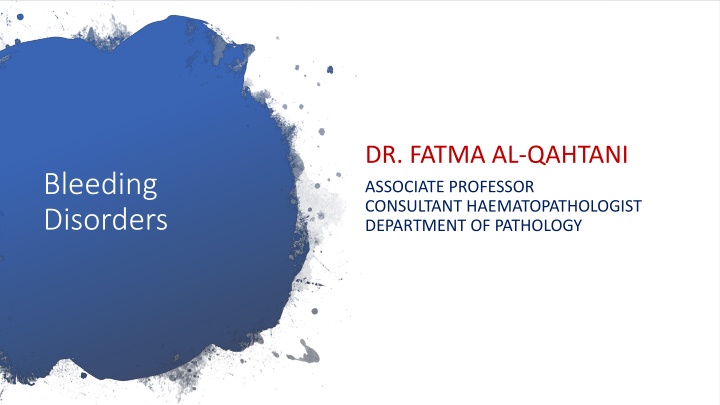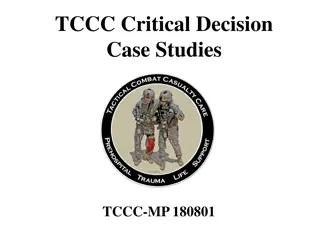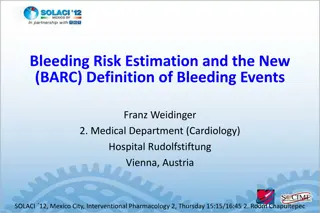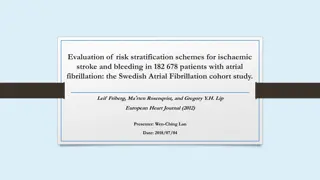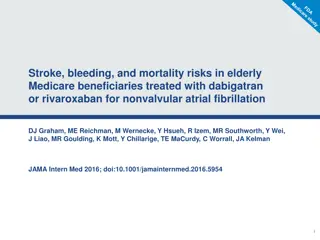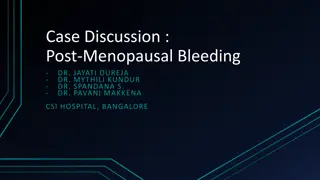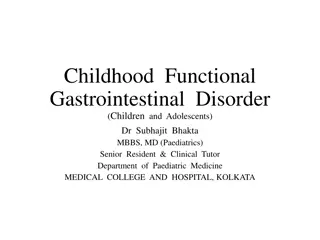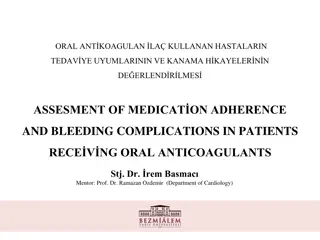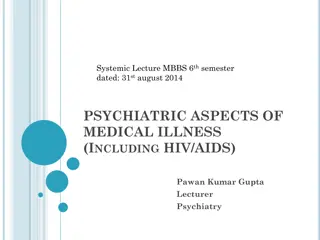Bleeding Disorders
Bleeding disorders encompass vascular disorders, thrombocytopenia, and defective platelet function or coagulation. These conditions result in easy bruising and spontaneous bleeding, with underlying abnormalities in vessels or perivascular connective tissues. Inherited disorders like hereditary haemorrhagic telangiectasia and connective tissue disorders such as Ehlers-Danlos syndrome contribute to these conditions. Acquired defects like senile purpura and the Henoch-Schönlein syndrome also manifest as easy bruising. Moreover, congenital coagulation disorders like hemophilia A and B, as well as von Willebrand disease, pose significant challenges. Hemophilia A, for instance, stems from abnormalities in the factor VIII gene, predominantly affecting males but rarely observed in females. Prenatal diagnosis of hemophilia can entail fetal DNA analysis through procedures like chorionic villus sampling.
Download Presentation

Please find below an Image/Link to download the presentation.
The content on the website is provided AS IS for your information and personal use only. It may not be sold, licensed, or shared on other websites without obtaining consent from the author.If you encounter any issues during the download, it is possible that the publisher has removed the file from their server.
You are allowed to download the files provided on this website for personal or commercial use, subject to the condition that they are used lawfully. All files are the property of their respective owners.
The content on the website is provided AS IS for your information and personal use only. It may not be sold, licensed, or shared on other websites without obtaining consent from the author.
E N D
Presentation Transcript
DR. FATMA AL-QAHTANI Bleeding Disorders ASSOCIATE PROFESSOR CONSULTANT HAEMATOPATHOLOGIST DEPARTMENT OF PATHOLOGY
Bleeding disorders result from: 1 Vascular disorders. Bleeding Disorders 2 Thrombocytopenia. 3 Defective platelet function. 4 Defective coagulation.
Heterogeneous group of conditions characterized by easy bruising and spontaneous bleeding from the small vessels. The underlying abnormality is either in the vessels themselves or in the perivascular connective tissues. Coagulation tests are normal. Vascular bleeding disorders
Inherited vascular disorders Hereditary haemorrhagic telangiectasia AD, Rare. Connective tissue disorders In the Ehlers Danlos syndromes there are hereditary collagen abnormalities with purpura resulting from defective platelet adhesion.
Simple easy bruising is a common benign disorder which occurs in otherwise healthy women, especially those of child bearing age. Acquired vascular defects Senile purpura caused by atrophy of the supporting tissues of cutaneous blood vessels The Henoch Sch nlein syndrome is usually seen in children and often follows an acute upper respiratory tract infection
Congenital Coagulation Disorders 1) haemophiliaA (factor VIII) 2) haemophilia B (factor IX) 3) VWD
Hemophilia A Deficiency of factor VIII results from an abnormality in the factor VIII gene, which lies at the the long arm of the X-chromosome. Ranging form single-point mutations to large deletions. The prevalence of this disorder is about one per 10 000 males. Females with haemophilia have been observed extremely rarely and these are either homozygotes for the abnormal gene or are heterozygotes in whom the normal X-chromosome has not produced sufficient quantities of factor VIII due to lyonization. In the plasma, factor VIII is only found complexed with VWF, which acts as a carrier and prolongs its plasma half-life.
Prenatal diagnosis of haemophilia can be made by analysis of fetal DNA, which can be obtained either by chorionic villus sampling between 11 and 14 weeks of gestation or by amniocentesis after 16 weeks. Genetic mutational analysis allows carriers to be identified with accuracy and is the method of choice. Hemophilia A
Clinical features Infants may develop profuse post circumcision haemorrhage or joint and soft tissue bleeds and excessive bruising. Recurrent painful haemarthroses and muscle haematomas dominate the clinical course of severely affected patients If inadequately treated, lead to progressive joint deformity and disability. Intracranial bleeding is the most common cause of death from the disease itself.
The possibility of haemophilia is suggested by the finding of a normal PT and a prolonged APTT. Confirmation is by a specific assay of factor VIII coagulant activity with normal VWF. Diagnosis
Coagulation factor activity (percentage of normal) Clinical manifestations <1 Severe disease Frequent spontaneous bleeding into joints, muscles, internal organs from early life Joint deformity and crippling if not adequately prevented or treated Correlation of coagulation factor activity and disease severity in haemophilia A or B. 1 5 Moderate disease Bleeding after minor trauma Occasional spontaneous episodes >5 Mild disease Bleeding only after significant trauma, surgery
Treatment Treatment should be given at the earliest sign of spontaneous or post-traumatic bleeding. Treatment consists of intravenous injections of factor VIII concentrate. Guidelines exist for the plasma level to be achieved for different types of haemorrhage. A controlled trial has proven that regular prophylaxis is far superior to on demand treatment. Approximately 25% of patients with haemophilia, usually after treatment with factor VIII on 10-20 occasions, develop antibodies that inhibit its functional activity.
Treatment Haemorrhage in patients with high-titre inhibitors may require treatment with bypassing agents such as recombinant factor VIIa or FEIBA (factor eight inhibitor bypassing activity; that is, a plasma-derived activated prothrombin complex concentrate), which activate the coagulation cascade below the level of factor VIII. The administration of factor VIII may be avoided in mild to moderate haemophilia by using the vasopressin analogue desmopressin (DDAVP), which causes a temporary increase in factor VIII and VWF by provoking the release of these factors from endothelial cells. DDAVP is used intravenously, subcutaneously or intranasally.
Haemophilia B (Factor IX deficiency, Christmas disease) The clinical features and inheritance of factor IX deficiency are identical to those in factor VIII deficiency. Factor IX deficiency affects about 1 in every 50 000 males. The factor IX gene is located on the long arm of the X-chromosome. The APTT is prolonged and the PT normal. The diagnosis can be made by assay of the factor IX level. Plasma-derived factor IX concentrate or recombinant factor IX is available and should be administered intravenously as soon as spontaneous or post-traumatic bleeding starts. Factor IX has a longer half-life in the plasma (18-24 hours) than factor VIII and hence can be given at less frequent intervals.
Von Willebrand disease It is an autosomal disorder characterized by mild, moderate or severe bleeding. VWF has two function: o binds platelets to subendothelial tissues. o It acts as a carrier for factor VIII. The most common inherited bleeding disorder withprevalence of up to 1% Most mild cases are undiagnosed. The bleeding results from either a qualitative abnormality or a quantitative deficiency of VWF. The reduction in VWF results in a reduction in factor VIII concentration (can be misdiagnosed as hemophilia A).
VWD VWD has been divided into three types: Types 1 (most frequent) partial reduction, AD Type 3 there is nearly complete absence of VWF molecules, AR Type 2 there are qualitative abnormalities, AD or AR Spontaneous bleeding is usually confined to mucous membranes and skin most commonly epistaxes and ecchymoses. Bleeding into joints and muscles is rare except in type 3 disease.
The laboratory findings include: Prolonged PFA closure time. Usually a prolonged APTT. Reduced factor VIII clotting activity Reduced levels of VWF antigen or activity. Impaired ristocetin-induced platelet aggregation. Diagnosis
For type 1 disease, desmopressin (DDAVP) is the first line treatment. DDAVP increases plasma levels of both VWF and factor VIII. Very high purity VWF concentrate may be used. The antifibrinolytic drug (tranexamic acid) may be used for treating epistaxis or menorrhagia. Treatment
Single deficiencies of factors other than VIII and IX are rare. Deficiency of other clotting factors All factors deficiency except contact factor (e.g. factor XII) give rise to bleeding disorders of varying degrees of severity.
Liver disease. Vitamin K deficiency DIC Acquired hemophilia. Drugs (heparin, warfarin, tPA, rivaroxaban, dabigatran) Acquired bleeding disorders
Vitamin K Deficiency Vitamin K Deficiency Fat soluble obtained from green vegetables and bacterial synthesis in the gut. Hemorrhagic disease of the newborn: oCaused by liver cell immaturity, lack of gut bacterial synthesis of the vitamin and low quantities in breast milk. ousually on the second to fourth day of life, but occasionally during the first 2 months. oPT and APTT are both prolonged.
Disseminated intravascular coagulation (DIC) Generalized activation of the clotting system followed by marked activation of the fibrinolytic system. Acute DIC may be associated many serious/lifethreatening diseases. Clotting cascade is activated in various ways( tissue damage, collagen exposure, release of TF and other procoagulants) Activation of the cascade leads to the generation and dissemination of large amounts of thrombin in the circulation, the activation of platelets and the formation of intravascular microthrombi. As a consequence of the fibrin formation, the fibrinolytic mechanism is activated, resulting in high concentrations of FDPs, including D-dimers.
Infections Gram negative and meningococcal septicaemia Clostridium welchii septicaemia Severe falciparum malaria Viral infection varicella, HIV, hepatitis, cytomegalovirus Malignancy Widespread mucin secreting adenocarcinoma Acute promyelocytic leukaemia Obstetric complications Amniotic fluid embolism Premature separation of placenta Eclampsia; retained placenta Septic abortion Hypersensitivity reactions Anaphylaxis Incompatible blood transfusion Widespread tissue damage Following surgery or trauma. After severe burns Vascular abnormalities Kasabach Merritt syndrome Leaking prosthetic valves Cardiac bypass surgery Vascular aneurysms Causes of DIC Miscellaneous Liver failure Pancreatitis Snake and invertebrate venoms Hypothermia Heat stroke Acute hypoxia Massive blood loss
The haemorrhagic manifestations may be so severe in acute DIC as to lead to death In chronic DIC, the haemorrhagic tendency may be mild or moderate. Some patients with chronic DIC are asymptomatic because the activation of the clotting and fibrinolytic systems is finely balanced and the production of clotting factors and platelets is sufficiently increased to compensate for their increased consumption. DIC
1 The platelet count is low. 2 Fibrinogen concentration is low. 3 High levels of fibrin degradation products (D dimers). 4 The PT and APTT are prolonged. 5 RBCs fragments in blood smear. Diagnosis Compensation by the liver may render some of the coagulation tests normal.
Treatment is aimed at preventing further coagulation by removal of the initiating cause. Supported with transfusions of blood, fresh- frozen plasma and platelet concentrates in order to restore blood volume and replace clotting factors and platelets. Treatment
Acquired haemophilia Acquired hemophilia is a rare but life-threatening condition Caused by the development of autoantibodies (inhibitors) directed against plasma coagulation factors, most frequently factor VIII (FVIII). Could be idiopathic or secondary to underlying condition (autoimmune disease, infection, malignancy, ) More common in the elderly Treated with bypassing agents such as recombinant factor VIIa or FEIBA and immune suppression.
Blood loss results in reduced levels of platelets, coagulation factors and inhibitors. Further dilution of these factors occurs during replacement with red cells. Some protocols include 1 : 1 : 1 for red cells, platelet packs and FFP Massive transfusion syndrome
